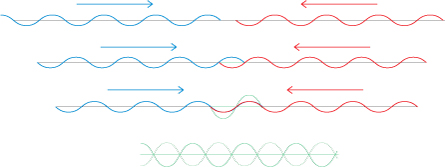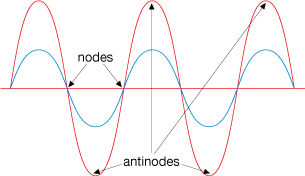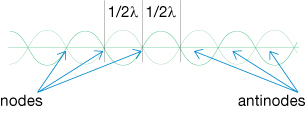Module 8—Mechanical Waves
Standing Waves and Musical Tones
As you observed in the simulation, when two identical waves approach one another, they begin to interfere. As the crest of one wave meets the trough of the other, destructive interference causes the medium to lay flat, as illustrated by the small red line, just as the two waves start to overlap. As the overlap continues, constructive interference also occurs when crests and troughs begin to meet one another. This produces a larger amplitude wave, as seen in the third line of the image below.

Figure 3
standing wave: a wave that appears not to be travelling (stays in a constant position)
antinode: a place on a standing wave with maximal amplitude
node: a place on a standing wave with minimal amplitude
The last part of the image shows a standing wave. This is the result when the two waveforms are completely overlapped. Since the waves continue to move, the combined waveform flips up and down. The pattern at work in the preceding Watch and Listen activity is shown in Figure 4. You will notice that in both the simulation and in Figure 3, there are points along the standing wave that do not move (hence the term standing) and points that move up and down at maximum amplitude. Points that do not move are called nodes, and points that move at maximum amplitude are called antinodes.

Figure 4

As illustrated above, the nodes are separated by one-half wavelength (½ λ) intervals, as are the antinodes.
In stringed instruments, such as a violin or guitar, there must be a node at each end of the string where it is attached to the instrument. This could be the physical end of the string or the point where the musician’s finger presses the string so that the string is in contact with the neck of the instrument. In each string on the instrument, there will be an integral number of antinodes between the nodes on each end of the standing wave patterns that are produced when the string is disturbed. In other words, the standing wave in the string will prefer to oscillate with a specific number of antinodes, producing a resonant frequency (recall the earlier definition of resonance). On musical instruments, the standing wave frequency is unique to the string and instrument and is observed by the human ear as a tone or note.
 Read
Read
Read “Standing Waves and Resonance” on pages 416 to 418 of your textbook.
 Self-Check
Self-Check
SC 4.
- What is the difference between a node and an antinode?
- How far apart will they occur?
 Self-Check Answers
Self-Check Answers
SC 4.
- A node is a place where complete destructive interference continually occurs so there is no motion, and an antinode is a place where constructive interference occurs at the maximum displacement.
- Nodes and antinodes are ¼ λ (one-quarter wavelength) apart.